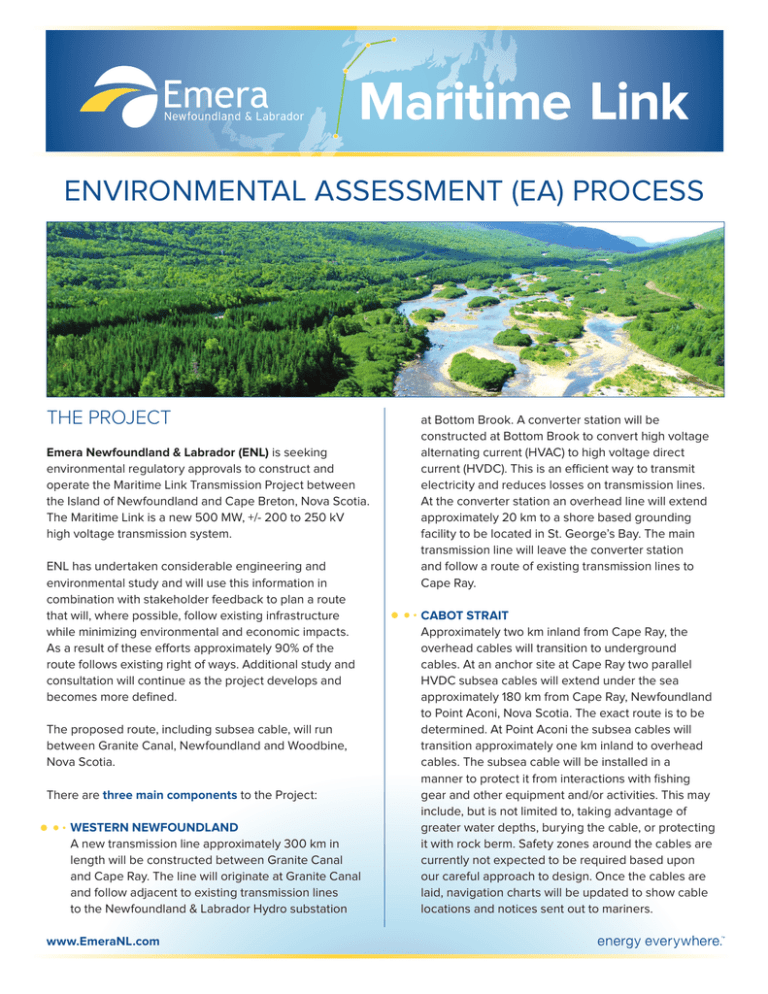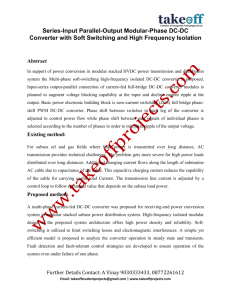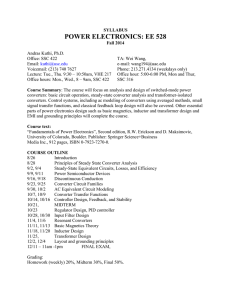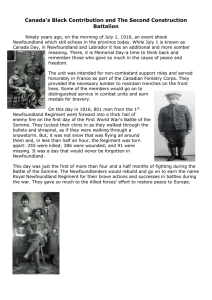environmental assessment (ea) process
advertisement

ENVIRONMENTAL ASSESSMENT (EA) PROCESS THE PROJECT Emera Newfoundland & Labrador (ENL) is seeking environmental regulatory approvals to construct and operate the Maritime Link Transmission Project between the Island of Newfoundland and Cape Breton, Nova Scotia. The Maritime Link is a new 500 MW, +/- 200 to 250 kV high voltage transmission system. ENL has undertaken considerable engineering and environmental study and will use this information in combination with stakeholder feedback to plan a route that will, where possible, follow existing infrastructure while minimizing environmental and economic impacts. As a result of these efforts approximately 90% of the route follows existing right of ways. Additional study and consultation will continue as the project develops and becomes more defined. The proposed route, including subsea cable, will run between Granite Canal, Newfoundland and Woodbine, Nova Scotia. There are three main components to the Project: Western Newfoundland A new transmission line approximately 300 km in length will be constructed between Granite Canal and Cape Ray. The line will originate at Granite Canal and follow adjacent to existing transmission lines to the Newfoundland & Labrador Hydro substation www.EmeraNL.com at Bottom Brook. A converter station will be constructed at Bottom Brook to convert high voltage alternating current (HVAC) to high voltage direct current (HVDC). This is an efficient way to transmit electricity and reduces losses on transmission lines. At the converter station an overhead line will extend approximately 20 km to a shore based grounding facility to be located in St. George’s Bay. The main transmission line will leave the converter station and follow a route of existing transmission lines to Cape Ray. Cabot Strait Approximately two km inland from Cape Ray, the overhead cables will transition to underground cables. At an anchor site at Cape Ray two parallel HVDC subsea cables will extend under the sea approximately 180 km from Cape Ray, Newfoundland to Point Aconi, Nova Scotia. The exact route is to be determined. At Point Aconi the subsea cables will transition approximately one km inland to overhead cables. The subsea cable will be installed in a manner to protect it from interactions with fishing gear and other equipment and/or activities. This may include, but is not limited to, taking advantage of greater water depths, burying the cable, or protecting it with rock berm. Safety zones around the cables are currently not expected to be required based upon our careful approach to design. Once the cables are laid, navigation charts will be updated to show cable locations and notices sent out to mariners. Nova Scotia A new transmission line less than 50 km in length will begin at a landfall transition compound near Point Aconi and will parallel existing transmission lines to a converter station at Woodbine. At the converter station an overhead line will extend to a shore based grounding facility. The location of this facility is to be determined. The converter station at Woodbine is considered the end of the project where the HVDC will be integrated into the existing Nova Scotia electricity grid. PROJECT COMPONENTS ⊲⊲ ⊲⊲ ⊲⊲ ⊲⊲ ⊲⊲ Subsea cables; Shore based grounding facilities; Two converter stations and adjoining substations; Transmission corridors; and Two transition compounds. PROJECT ACTIVITIES Project activities associated with construction of the Maritime Link include: Access and clearing — Through our careful design planning, approximately 90% of the routing required for the construction and maintenance of the project is already accessible. Although existing access roads will be utilized to the full extent possible, construction and transmission lines along existing rights of way or through new corridors may still involve creating new access routes. Construction of high voltage ac/dc converter stations — Converter stations transform HVDC to HVAC and HVAC to HVDC. The structures will consist of a concrete foundation; galvanized steel structures to support the electrical equipment and switchgear; a building containing infrastructure that requires sheltering; associated office and maintenance areas; and an access road. This will be similar in size to a small warehouse. Installation of transmission infrastructure — Installing transmission towers includes construction of foundations, tower assembly and erection. A conductor is attached to the transmission towers by rolling it onto the line using stringing blocks or pulleys to run from tower to tower. Once the conductors are attached, each tower is inspected to ensure that all connections are in place and the conductor is correctly tensioned. Installation of grounding systems — A grounding system involves two components: an overhead line from the converter station and the shore based grounding site. The grounding lines will utilize existing corridors or parallel existing corridors where possible in an effort to reduce the amount of new land required. While scaled in size to meet our needs, this type of system is a part of every electrical system, including your home. The ground rod is usually at the base below your power meter. Laying of the subsea cable — Cable will be laid following natural protective features such as deep sea valleys and ocean contours. Cable will be loaded onto a cable-laying vessel and transported to the site where the cable is eventually laid. The cable will be laid on the seabed and protected by burying or rock berm placement; at greater depths no protection will be required. ENVIRONMENTAL ASSESSMENT PROCESS Distribution of materials — Steel sections for transmission towers, wire reels and hardware required for construction will be distributed along the transmission corridor access routes by vehicles or other suitable equipment. Helicopters may be used as required. www.EmeraNL.com The Maritime Link Project is currently undergoing an Environmental Assessment (EA) which will determine if the project will be permitted to proceed. This process is managed by regulatory authorities that administer the review and make a recommendation for project approval to the Minister responsible. This is a formal environmental regulatory review process that is completed on all similarly proposed development initiatives. Environmental assessment is a mechanism for reviewing projects to predict environmental effects of proposed initiatives. The process is administered by law through the federal and provincial government(s) where the project will be developed to ensure that projects proceed in an environmentally acceptable manner. The EA process is a critical part of regulatory compliance for the project. In addition to providing direction for regulatory approvals associated with Project activities (such as, avoiding or minimizing watercourse alteration, in-stream activity, constructing access roads and trails only where necessary, and development on crown lands), the EA process encompasses compliance and effects monitoring as part of the overall regulatory approval. ENL is preparing an Environmental Assessment Report, which will be reviewed by regulators, the public and Aboriginal groups. Included in this document will be an outline of potential environmental and economic effects of the Maritime Link Project and actions to help increase positive effects and mitigate potential negative effects. As part of this process the Maritime Link project team will be: 1. Identifying and evaluating the Project’s benefits and potential effects; 2. Assessing and proposing measures to mitigate or reduce potential adverse outcomes and to enhance benefits; 3. Predicting whether there will be significant adverse environmental effects; and 4. Engaging potentially affected or neighboring Aboriginal peoples, stakeholders and the general public throughout the process. Based on the Environmental Assessment Report, each regulatory body will decide if any terms and conditions need to be included if approval for the Maritime Link Project is granted. ENVIRONMENTAL ASSESSMENT SCHEDULE EA SUPPORT STUDIES Defining a Study Area for the establishment of a Route STUDY AREA Existing Infrastructure Study areas vary in width from 500m in NS to a minimum of 2km in NL. As part of the Environmental Assessment process, Emera Newfoundland & Labrador has identified a Study Area for the purpose of environmental assessment that is larger than the area that will ultimately be required to determine the defined transmission route for the Maritime Link Project. This study area was chosen based on early planning and research, beginning with origin and destination points for the transmission of electricity, as well as the location of existing and new supporting infrastructure. www.EmeraNL.com Using this Study Area ENL conducted approximately 20 studies starting in 2011, continuing in 2012 and ongoing through subsequent phases of the project. Through these studies information has been gathered on vegetation and wildlife, land and resource use, traditional land use, historic and heritage resources, and freshwater and marine environments. Extensive work has been done in an effort to parallel existing transmission lines resulting in optimization of existing access points and minimizing impacts on the environment. Some of the studies conducted include the following: Study Consultant Mi’kmaq Fisheries Unama'ki Institute of Natural Resources Avifauna Stantec Consulting Cabot Strait Geophysical/Geotechnical Survey Fugro Commercial Fisheries CEF Consultants Cultural Resource Assessment CRM Group EA Support Consultant Stantec Consulting Ecological Land Classification CBCL Consulting Ltd. Freshwater Watercourse ID/fish habitat Sikimuit Large Mammal Studies Stantec Consulting Marine Acoustic Jasco Research Marine Benthic Ecology Nearshore Stantec Consulting Marine Benthic Ecology Nearshore McGregor Geoscience Metocean Study Oceans Ltd. Mi'kmaq Ecological Knowledge Study Membertou Geomatics Services Noise Assessment - Converter Stations Stantec Consulting Orthophotography First Base Solutions Sediment Transport Modelling CBCL Consulting Ltd. Socio-economic Assessment AMEC Viewscapes Assessment CBCL Consulting Ltd. PUBLIC ENGAGEMENT ENL’s principles of engagement focus on being the best source of information with respect to the Project and initiating early engagement to identify concerns and respond quickly. Public consultation with respect to the Maritime Link Project began in the spring of 2011, well in advance of the formal initiation of the EA process on November 30, 2011. Stakeholder outreach has included regulatory agencies, local residents, landowners, commercial fishers, industry, the business community, guide outfitters, hunters, anglers, special interest groups, and the general public. www.EmeraNL.com Engagement has involved identifying and addressing concerns and interests as these relate to Project components and activities and have identified a broad range of interests. Engagement opportunities have included, but are not limited to: one on one meetings, technical workshops, supplier sessions, open houses, and presentations to industry groups. The public may also comment on the Project through the environmental assessment process (see EA schedule on previous page). NOTES www.EmeraNL.com CONTACT US If you have any questions about the Project or would like to be included in ongoing communications, you may contact Emera Newfoundland & Labrador at: 1-855-722-3373 info_MaritimeLink@emera.com For Project updates please visit www.EmeraNL.com. Emera Newfoundland & Labrador welcomes and encourages participation from all interested parties. www.EmeraNL.com


